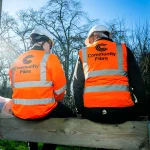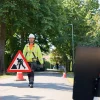Openreach Update as Analogue UK Phone Switch Off Delayed to 2027 UPDATE

In case anybody missed it after being buried in yesterday’s BT results (here). The plan to withdraw BT and Openreach’s old copper-based analogue line services (PSTN phones and WLR), which was due to complete by December 2025, has been delayed until 31st January 2027 in order to give broadband ISPs, telecare providers and consumers more time to adapt.
The announcement wasn’t particularly well signposted in BT’s press release, but if you read the full report it said this: “Following the industry-wide pause to non-voluntary migrations in December 2023, we now expect to have migrated all customers off the PSTN by the end of January 2027, allowing us to align the programme with full fibre broadband customer upgrades where available.” Openreach then promptly mirrored this move (here).
The delay to the industry-led migration had been expected for a while now (here) and, despite BT’s results merely linking it to their full fibre (FTTP) broadband roll-out (i.e. reaching 25 million premises by December 2026), it’s already well understood that the accompanying transition to digital phone alternatives was going through a bit of a rough patch.
Advertisement
In place of PSTN/WLR, many comms providers are introducing Internet Protocol (IP) based digital phone / voice services, which require a broadband connection in order to work (either via copper or full fibre). Put another way, you plug your existing handset into the back of a broadband router (assuming it has a phone port) or Analogue Terminal Adapter (ATA), rather than the old wall socket. Simple enough? Not so for everybody.
A Problematic Migration
However, the new generation of IP based phone solutions do have the odd caveat, aside from being a little bit more complex to setup. For example, the new services are not remotely powered (i.e. if there’s a power cut, they go down, but ISPs can provide a limited battery backup solution upon request) and often don’t work properly with older alarm or telecare monitoring systems.
The issue of poor telecare support is largely the fault of telecare and alarm providers (i.e. failing to upgrade their systems), but this doesn’t change the reality that nearly 2 million people use these vital systems in the UK (e.g. elderly, disabled, and vulnerable people). Often these exist in rural and isolated areas, where mobile services may also go down during power cuts. Ofcom are separately reviewing mobile resilience, but complex issues of cost and wayleaves may yet create some barriers to improving that.
Suffice to say, there was a high risk that the digital phone switch-over could put a significant number of vulnerable people’s lives at risk, which was tragically underlined by the recently reported deaths of two “vulnerable” Virgin Media Phone customers (here). This is alleged to have occurred after their health alarms failed, following the switch-off of their old analogue phone services. Ofcom are currently investigating VM’s handling of the digital phone migration (here).
Advertisement
The result is that the transition to digital phone solutions has been delayed from 31st December 2025 to 31st January 2027.
An Openreach spokesperson told ISPreview:
“BT has announced its decision to move out the date for switching off the PSTN – the old copper based analogue phone network.
In response to this – Openreach has taken the decision to align the withdrawal of our products that work over it – which come under the umbrella term of Wholesale Line Rental (WLR), with the new switch off date of 31 January 2027.
Openreach will continue to work with its Communications Provider (CP) customers to help them migrate their customers onto new digital services and off the legacy network as safely and smoothy as possible.
We also recognise there’s more work to do to reach and mobilise the minority of non-engaged CPs to migrate their customers off WLR proactively and safely.”
However, it is important to stress that the old services will still have to be withdrawn eventually (most lines should have transitioned before the new deadline), which is because keeping the old analogue services going would be both extremely expensive (i.e. maintaining a large network to support a minority of users) and highly risky – due to the ancient kit no longer being fully supported or phased-out by many manufacturers.
On the upside, Openreach and BT have recently begun to pilot a new SOTAP for Analogue product (here), which is a phone line service that does NOT require broadband to work and can harness modern networks to function similarly to the older analogue service.
The solution, once introduced, would not be available for new service provisions (only existing / vulnerable customers) and is intended to be a temporary product (possibly running until around 2030). In theory, this would allow more time for people and networks to adapt, but it won’t be launched until toward the end of 2024 and the new delay should make this a little smoother to implement.
Advertisement
UPDATE 18th May 2024 @ 7:10am
According to our sources, Openreach’s approach to this means they’ll still be terminating existing WLR contracts for ISPs at the end of December 2025 and expect the migration to continue at pace, which is in line with the previous plan. But after this date, the operator will introduce new terms and a three-month termination notice period to continue services where needed and enable some flexibility to support future processes.
In addition, the network operator is also having to deal with a very small number of comms providers that have not responded to the looming WLR/PSTN switch-off and is understood to be developing a plan for tackling those.
Some readers have also asked about the question of PSTN’s declining reliability as it gets older. According to data in Ofcom’s Connected Nations 2023 report, the number of PSTN incidents increased by 20% last year and there was a 60% increase in hours lost for customers on the PSTN.
Mark is a professional technology writer, IT consultant and computer engineer from Dorset (England), he also founded ISPreview in 1999 and enjoys analysing the latest telecoms and broadband developments. Find me on X (Twitter), Mastodon, Facebook, BlueSky, Threads.net and Linkedin.
« Bolton Council Take Enforcement Action Against IX Wireless Broadband Poles






















































“IP based phone solutions do have the odd caveat, aside from being a little bit more complex to setup” – there’s an understatement!
There’s probably some kind of turnkey system where an ISP can send you a pre-configured uneditable ATA, but every ATA I’ve used is configured via a web admin interface like this:
https://langui.sh/assets/media/2009/12/pap2t.png
Yes, all the major VoIP device manufacturers have provisioning services, where the provider registers the hardware address of the devices they supply with the service, when the device turns on it’s directed by the manufacturers server to the service providers own server, which configures the device, often including disabling the web interface. It works for ATAs as well as VoIP phones.
That’s how they are able to send you “pre-configured” devices which they’ve never actually opened, they just scan a bar code on the box to link it to your line settings.
Ahh, interesting. Good to know. Thanks.
There will still be telecare providers having a good hard cry to various newspapers in the middle of 2026 that they won’t be ready to switch by January, Openreach even call them out above that they are “non-engaged CPs” which is one of the few times I’ve seen groups of customers blamed for the problem. I hope WLR3 price increases cover the increased costs of delaying this rather than it having to be paid for on the service bills of people who engaged with the switch to IP.
telecare providers aren’t Openreach WLR CPs though. Aside from the BT brands, it’ll be the very small ISPs who offered WLR largely as a convenience to customers, avoiding the need for two bills.
I’d be surprised if BT doesn’t end up closing the PSTN before 2027 anyway. If “SOTAP for analogue” is proven to be reliable enough then that eliminates the biggest barrier and they can shift customers over in a big way. Although we might then learn of all the businesses with ISDN30s that still haven’t upgraded to SIP trunking or a cloud voice service!
We have BT Digital Voice system in our house and it’s a pain in the backside whilst the call quality is a step up from the old system the issue comes when the power goes down and you have no phone system at all and for us it means our mobiles go down too as we can’t get a usable mobile phone signal where we live.
While it’s a good idea in theory, in reality it’s significantly flawed due to the power issue and when I have mobility issues with arthritis and mum has dementia,a phone line is essential, perhaps BT & telecoms companies should supply their customers with a UPS with a >12h capacity to keep them connected at all times.
> perhaps BT & telecoms companies should supply their customers with a UPS with a >12h capacity to keep them connected at all times
Or perhaps you should supply yourself with a UPS? That way you can choose the runtime, how many devices you want it to support, etc. My partner and I work from home so we have a couple of UPSes at home — one for the internet and one for our desks.
That’s exactly what they will do
https://www.bt.com/help/landline/digital-voice–will-my-service-work-in-a-power-cut-#:~:text=What%20if%20I'm%20vulnerable,phone%20or%20existing%20corded%20handset.
the power issue was present for most landline users anyway due to the use of cordless phones that needed mains power.
BT *does* provide a free UPS to customers it knows to be vulnerable (though I’m not sure what the runtime is supposed to be), have you asked for one?
Why 12 hours or more? That’s considerably longer than any realistic power cut unless there’s a natural disaster.
The percentage of people actually effected is decreasing all the time and by moving the date to January 2027 provides another year for this to progress.
The utilisation of the PSTN is reducing drastically but the cost is not currently being passed on to those remaining (to avoid PR flack). Those with a traditional voice land line only are effectively being subsidised which will continue to rise as PSTN usage falls. Why should this cost on other customers?
The power failure issue is also often overstated. Many people over time have swapped their corded phones for cordless phones and I have see care alarms that need mains. So the traditional phone line isn’t the only issue. Yes there are some very isolated premises and solutions will be there for them. DV, VoIP and VoLTE can easily be made resilient
Yes some form of UPS is needed going forward, not just for telephony, but other things as well including the network and devices you use. Longer term many houses may have some form of power storage or solar (that still works when power fails). If people are dependant on comms (which most of us are now) then consumers need to address it themselves.
The main providers are doing a lot, mainly to protect their PR. offering UPS or battery backed options to vulnerable customers. OR have an IP option if some landlines need to remain.
OR will still focus on the priority exchanges they need to clear and can always remove surplus PSTN capacity to reduce the power consumption in the others. SOTAP Analogue/Pre-Digital.
Priority has to be getting the switch/cease rate up so that the number of lines falls as quickly as possible to the minimum so OR know where to place their contingency kit.
Power cuts are pretty unusual and power cuts and no mobile signal are even rarer, If you do full into that battery though you have the option of battery backup
@Ivor it doesn’t take a “natural disaster” to cause a >12 hour power cut. Just last month, a 400-year old oak down the valley went down, sliced through the HV and LV on the way and narrowly missed a pole-mounted transformer. But it took 4+ hours to find out that the transformer wasn’t damaged as the tree was blocking access. As it was, with minor damage (2 cables, t-bar and insulators) it was 11 hours before we were back on supply. We had an 18+ hour outage in one of the storms 2 or 3 years ago, which wasn’t classed as “natural disaster”.
Think it’s just rural areas? 20,000 customers off-supply for over 24 hours in Dartford/Bexleyheath in 2009. https://www.bbc.co.uk/news/uk-england-11606539.
Everyone thinks their mains power is reliable. Until it isn’t.
@meadmodj – standard solar PV installations don’t work when the power is out (anti-islanding protection). It can be done but requires a more complex design and wouldn’t normally be done as standard.
If you in a area with known power problems you might be using a battery inverter with the green protected sockets outlets (sunnyboy/solaredge/enphase/victron or China ones can )
for key appliances (lights, fridge/freezer, heating, sump pump if below the waterline, broadband/cordless phone)
Mike – with your odds I’d probably start buying lottery tickets.
I stand by what I said – UK power isn’t *that* unreliable, even in rural areas – and trees falling (I’d say that’s a kind of natural disaster) could just as well fall on BT cabling just as much as it did the power in your case. So much for the allegedly rock solid POTS line then (or when it gets a bit wet, or when a JCB goes through it, or a car runs into the cabinet, or Openreach or their contractor make a mistake as recently happened to me, or when the 40 year old PSTN kit finally carks it)
You’ll say some of these faults will impact VDSL/FTTP too – and they might – but at least there’s scope to run a VoIP based landline over 4G (though BT currently does not, except with business customers)
Prefer the system the way it is . new IP
voice is not fit for purpose at the moment
You prefer service from obsolete 40 year old equipment with ever declining amounts of expertise to support it? How long do you think that’s viable for?
Thanks to many others like me the older networks will be around for a long time yet
The PSTN closure date: Let’s see, not 31/12/2025, possibly 31/01/2027, could even be 12/of/NEVER, and that’s a long long time! 😉
So that’s one pensioner taking precautionary lessons from Bongo Eddy now.
Surely this is another molehill being turned into a mountain (To keep a few more redundant exchange engineers going on an unofficial job creation scheme ?).
Even the Openreach ECI white modems knocked out in 2012 had a socket for battery back-up (Although sealed-up) and a small a cheapo power bank (30,0000mah) could keep that modem going for 2 and a half hour. Sufficient time for an alarm text/ e-mails to be sent to a central web-site onward transmission to and viewing by viewing by care providers. Then it would be over to them.
Interestingly my mum who isn’t in an FTTP area got an email from Vodafone wo weeks advising they were sending a phone to router adapter (phone connector to RJ11) as they were moving her to Digital Voice and then a text from OpenReach Today to say the switchover is happening next week.
PSTN switch off does not require copper broadband services to be removed. Copper based broadband will be here for the next decade at least.
“the new generation of IP based phone solutions do have the odd caveat, aside from being a little bit more complex to setup.”. I have the Cisco CCNA qualification and even I struggle setting up my Grandsteam HT802 and Gigaset N300A. How they think people will set these things up is unreal. It is easier to setup a PFsense firewall than it is these Voip boxes. And that is saying something.
An end user doesn’t need to know how to configure these devices themselves any more than they need to know how to provision their line on a System X exchange. They pick their provider and are sent a box to plug in, which may also be a broadband router. Nobody needs to get into the weeds of configuring an ATA unless they choose to.
Presumably you will still be able to get a copper service but nobody will supply it to you apart from BT. Who will charge 50% more. Everyone else is gradually becoming no telephone service or voip only, sometimes without admitting it. Tried to get an adsl service lately? There is not much legacy out there.
VM article behind a paywall.
@Ivor power cuts of more than 12 hours are not unusual if there is widespread damage to power lines.
and currently if you lose your PSTN line due to a fault on the line then Openreach can take up to 48 hours to fix it – starting from midnight on the day you report it and not including midnight Friday to midnight Sunday – so a fault (e.g. no dialtone/service) reported on a Friday may not get fixed until the following Tuesday. If some idiot sets fire to the local cabinet or crashes into it in his Corsa, then you can be without a voice line for weeks. This is NOT a new problem!
Is there any particular reason why these telecare devices etc don’t work on VoIP?
The majority don’t use IP to communicate and were specified for PSTN using built in modems. There’s no technical reason whatsoever why the same service can’t be provided over IP, but the entire healthcare sector including the NHS is bedevilled by instances of equipment that rely on long obsolete software or connectivity standards. I think the root cause of that is simply under-investment by manufacturers, service providers, and customers. Given the lead times on equipment design and manufacture, and natural turnover of service and device technology, it is also possible that PSTN phase out committed to in 2017 was simply not enough time for providers and consumers in the telecare sectors unless they were already offering or planning to offer IP connected devices.
This is on a leaflet from Age Co (owned by Age UK) pushed through my letterbox a few months ago:
“BT have announced that by 2025 all analogue phone lines will be replaced with digital ones. Our fully-automated personal alarms are future proof and do not rely on a telephone landline”
I think most probably would work with digital voice but it is the lack of line power / battery backup that is the issue.
The company I work for still uses dial up modems to manage equipment in remote areas and I do this working from home on digital voice just fine.
I was switched to Digital Voice with Vodafone this week. The newly supplied router had an ATA port… except it didn’t work with either of my analogue phones. I borrowed a neighbour’s analogue handset which did work with his DV router.
Confirmed my handsets are “too old” which is what VF’s second line tech support gad8 said, which I didn’t didn’t believe. One, N300A DECT base station, I think, is still being sold.
Sooo… be warned. DV might require new handsets too. Not ideal, more expense for average user, beyond a possible UPS requirement.
Power cuts are not common and to get a power cut and no o mobile signal even rarer and even rare to need to make an emergency call at that time. If you so think you will fall into that category get battery back up
When will people realise that the old PSTN network was (and still is) unreliable as hell?
The ISP’s I have worked for have all handled hundreds of PSTN faults a week, all year round, resulting in people having no phone line for up to 3 weekdays, or 5 days if the fault is reported just prior to a weekend.
This will of no doubt affected vulnerable people with care alarms but it has never been made into a media circus, as is the case now.
The dangers for vulnerable people have always been there, and will most probably not increase through the use of VOIP.
This is the problem. I work in a telecoms related industry. Our stuff that connects to analogue line/trunk systems is basically EOL. We’re still selling it but haven’t invested in years. It’s a dead market. It’s the same with the firms making the switching equipment – they won’t be making new stuff and probably haven’t for years. Putting your head in the sand and expecting this 20+ year old kit to keep working is silly. (You can switch 1000s of voip lines in a router not much bigger than a cereal packet in place of an old analogue exchange building – the electronics needed for analogue are massive and expensive).
Anyone with service from a FTTP provider like Hyperoptic, B4RN, Truespeed, Gigaclear etc. will have a VOIP based phone service with the power issues etc. mentioned above.
Interesting advertising from one or more companies saying BT is switching off landlines which is not true.
Meanwhile…
Openreach hasn’t anything better than ADSL to offer plenty of places.
Maybe sort that out before bitching on about killing PSTN. GET PN WITH IT. Not even having VDSL/FTTC/SOGEA in 2024 is ridiculous.
Other suppliers are available.
The issue being that building a new network aka FTTP will take time, but the build isn’t linear. The plan is to have FTTP available to 25 million properties by 2026 however after this point the build is going to slow down as the next 5 million properties aren’t going to be as easy to build to. More rural or in harder to reach areas. As more and more people are both switching to FTTP and those who are staying on fttc for the time being are choosing broadband only products. There is no way that Openreach can realistically maintain a PSTN network that has the ability to connect to every phoneline for the benefit of less and less people. There has to be a point of balance and that point is fast approaching. It’s a step that has to happen to make the project to build FTTP to all, a viable option. It is precisely because in many areas, fttc is not a viable option due to copper line length/age or even worse, aluminium lines, that the PSTN switch off to allow a proper upgrade of the UK infrastructure is needed.
Arguably this should have happened 15 to 20 years ago, or had Thatcher not put the kaibosh on fibre installations in the 80s, who knows what the network would look like now.
I don’t see the rush TBH
The current exchange equipment is obsolete, that’s why.
So much is made of the new network being FTTP with all the speed advantages that might bring.
All fine and good – if your line is on overhead supply you will/are getting FTTP.
I’ve never yet seen an existing customer with underground cabling final mile with anything better than fibre to cabinet and as far as I can make out FTTC is all that most of us are ever going to get cos none of the providers are ever going to shoulder the cost of replacing those buried cables, not that anyone ever says so!
So actually huge numbers of us will never get the speed and quality (my FTTC manages just under 30mps download and 4 up) but we do get the hassle and cost of having to provide our own UPS.
We have five households in my immediate family spread from Dorchester, Bournemouth, Oxford and Hatfield all in suburban locations. NONE of us has usable mobile phone signal at any time (providers tell us we are all in 100% coverage areas)
We DO get regular power outages, while most are less than one hour duration at least one a year is more than six hours and last year a major supergrid substation in Toddington failed and left county wide disruption for over two days.
In anything over 30 mins disruption local mobile networks go down, I imagine as mast UPS systems are depleted by increased traffic. Did anyone ever tel the mobile networks they were supposed to be backstopping an ill conceived comms ‘upgrade’
Seems to me that the advantages of this change are heavily weighted in favour of exchange operators at the expense of subscribers.
Point of interest: my (ex GPO) father is under the impression that theft of telephony services on the PTSN is actually prosecuted from the legal standpoint as theft of power from the network.
> I’ve never yet seen an existing customer with underground cabling final mile with anything better than fibre to cabinet
Millions of properties are supplied FTTP via underground footway boxes and underground ducts. The reason you’ve not seen these is probably because they’re all underground!
There are some photos of the equipment used in the links in this article:
https://www.thinkbroadband.com/news/8620-a-walk-in-a-fibre-wonderland-pictures-of-fttp-roll-out-in-lingfield
e.g. 12-port FTTP manifold (CBT) which sits in a chamber but raised for access:
https://www.thinkbroadband.com/assets/images/news-2019/12-port-manifold.jpg
I don’t doubt that millions of properties are supplied with instreet ducts and that *some* more recent builds will have duct from street to property but how many older (say pre 2000)have duct to property? The pictures you link show highway installations only and the write up conveniently glosses over underground connection from hub to proerty while making much of pole mounted lines – the problem arises in getting that fibre from the street ducts and chambers you picture – across the frontages of the properties where there is NO DUCT and the area has no overhead infrastructure.
I don’t mean to be rude as I have no idea of your position in this debate but your reply is typical of the way the industry conveniently fails to answer/ignores the question, a question that I have asked in several other places already!
To ask again more explicitly:
How will fibre reach my house from the ducted street cabinets and chambers when my current connection is a direct buried cable under my (expensively) paved frontage to a cabinet that is over a mile down the road? Anybody here with a vested interest give a truthful answer to that one?
I’m not even going to mention today’s worldwide internet outage and its effect on Voip services versus PSTN 🙂
So this is the OR report on my area:
FTTP is not available.
The exchange is not in a current fibre priority programme
As a WLR withdrawal exchange, product restrictions apply
SOADSL is not restricted at the exchange
For all ADSL and WBC Fibre to the Cabinet (VDSL or G.fast) services, the stable line rate will be determined during the first 10 days of service usage.
For all SOADSL services,the stable line rate will be determined during the first 10 days of service usage.
Actual speeds experienced by end users and quoted by CPs will be lower due to a number of factors within and external to BT’s network, Communication Providers’ networks and within customer premises.
If you decide to place an order for a WBC fibre product, an appointment may be required for an engineer to visit the end user’s premises to supply the service
In order to be eligible for handback, downstream speed should be less than Downstream Handback Threshold values.
ADSL, ADSL2+ and SOADSL availability: If shown at FTTP or SOGEA premises,ADSL, ADSL2+ and SOADSL are not available to order due to WLR Withdrawal stop sell rules. CPs should order FTTP or SOGEA. Copper products are only available by exception.
Thank you for your interest
No FTTP even being considered and I’m sure the reason is that the vast majority of the town is DIG connections